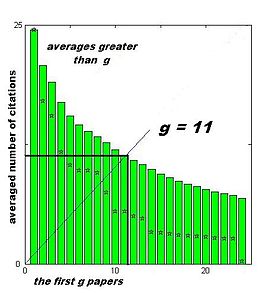Berger code
Template:Lowercase The g-index is an index for quantifying scientific productivity based on publication record. It was suggested in 2006 by Leo Egghe.[1]
The index is calculated based on the distribution of citations received by a given researcher's publications:
- Given a set of articles ranked in decreasing order of the number of citations that they received, the g-index is the (unique) largest number such that the top g articles received (together) at least g2 citations.
Just as with the h-index, the g-index is a number which is the same for two different quantities:
g is (1) the number of highly cited articles, such that each of them has brought (2) on average g citations.
This is in fact a rewriting of the definition
as

In other words, this means that in order to have a g-index of n an author that produces n articles should have, on average, n citations for each of them. Unlike the h-index, the g-index depends on the full citation count of very highly cited papers. Roughly, h is the number of papers of a quality threshold that rises as h rises; g allows citations from higher-cited papers to be used to bolster lower-cited papers in meeting this threshold. Therefore, in all cases g is at least h, and is in most cases higher.[1] However, unlike the h-index, the g-index saturates whenever the average number of citations for all published papers exceeds the total number of published papers; the way it is defined, the g-index is not adapted to this situation.
The g-index has been characterized in terms of three natural axioms by Woeginger (2008).[2] The simplest of these three axioms states that by moving citations from weaker articles to stronger articles, one's research index should not decrease. Like the h-index, the g-index is a natural number and thus lacks in discriminatory power. Therefore, Tol (2008) proposed a rational generalisation.[3] Template:Clarify
Tol also proposed a collective g-index.
- Given a set of researchers ranked in decreasing order of their g-index, the g1-index is the (unique) largest number such that the top g1 researchers have on average at least a g-index of g1.
See also
References
- ↑ 1.0 1.1 Egghe, Leo (2006) Theory and practise of the g-index, Scientometrics, vol. 69, No 1, pp. 131–152. Electronic Instrument Positions Staff (Standard ) Cameron from Clarence Creek, usually spends time with hobbies and interests which include knotting, property developers in singapore apartment For sale and boomerangs. Has enrolled in a world contiki journey. Is extremely thrilled specifically about visiting .
- ↑ Woeginger, G.J. (2008) An axiomatic analysis of Egghe’s g-index, Journal of Informetrics, vol. 2, pp. 364–368. Electronic Instrument Positions Staff (Standard ) Cameron from Clarence Creek, usually spends time with hobbies and interests which include knotting, property developers in singapore apartment For sale and boomerangs. Has enrolled in a world contiki journey. Is extremely thrilled specifically about visiting .
- ↑ Tol, R.S.J. (2008) A rational, successive g-index applied to economics departments in Ireland, Journal of Informetrics, vol. 2, pp. 149–155. preprint

